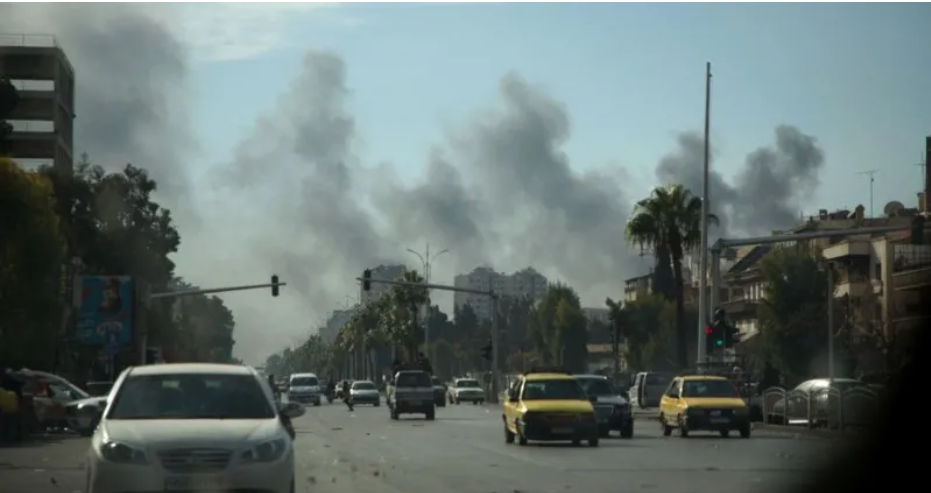Israel carries out dozens of air strikes across Syria, reports say
Syrian media reports indicate that Israeli warplanes have launched numerous airstrikes across Syria, including in the capital, Damascus. The UK-based Syrian Observatory for Human Rights (SOHR) reports over 100 attacks targeting military installations. Among the sites struck was a research center suspected of being linked to chemical weapons production, according to local media.
Israel states that its actions are aimed at preventing weapons from falling into the hands of extremists following the collapse of President Bashar al-Assad’s regime. Meanwhile, the UN Security Council is convening to discuss the evolving situation in Syria after Assad’s downfall.
The SOHR reports that hundreds of Israeli airstrikes have occurred in the past two days, including one on a facility in Damascus believed to have been used by Iranian scientists for rocket development.
These airstrikes coincide with warnings from the UN’s chemical watchdog, the Organisation for the Prohibition of Chemical Weapons (OPCW), urging Syrian authorities to ensure the safety of suspected chemical weapon stockpiles.
The OPCW defines chemical weapons as substances designed to cause intentional death or harm through their toxic properties. The use of such weapons is prohibited under international law, regardless of the presence of a legitimate military target, due to their indiscriminate nature.
While the exact quantity and location of Syria’s chemical weapons remain unclear, it is believed that former President Assad maintained stockpiles, with suspicions that his declaration to the OPCW was incomplete.
Syria signed the OPCW’s Chemical Weapons Convention in 2013, following a sarin gas attack on Damascus suburbs that killed over 1,400 people. Western nations attributed the attack to Assad’s regime, though Assad blamed the opposition.
Despite the OPCW and the UN overseeing the destruction of the 1,300 tons of chemicals declared by Syria, chemical attacks have continued. A 2018 BBC analysis confirmed that chemical weapons were used in at least 106 incidents during the Syrian Civil War between 2014 and 2018.
On Monday, the OPCW stated it had contacted Syria to emphasize the importance of securing all chemical weapons-related materials and facilities. Additionally, Israel’s military released photos of its troops crossing from the Israeli-occupied Golan Heights into Syria’s demilitarized buffer zone, where UN peacekeepers are stationed.
It comes a day after Israeli Prime Minister Benjamin Netanyahu announced that the military had temporarily seized control of the so-called Area of Separation, saying the 1974 disengagement agreement with Syria had “collapsed” with the rebel takeover of the country.
The Golan Heights is a rocky plateau about 60km (40 miles) south-west of Damascus.
Israel seized the Golan from Syria in the closing stages of the 1967 Six-Day War and unilaterally annexed it in 1981. The move was not recognised internationally, although the US did so unilaterally in 2019.
Speaking at a news conference on Monday, Saar said the Israel Defense Forces (IDF) was only making “a very limited and temporary step” taken for “security reasons”.
He also claimed that Israel had no interest in meddling in internal Syrian affairs and was concerned only with defending its citizens.
Defence Minister Israel Katz meanwhile said the Israeli military would “destroy heavy strategic weapons” – including missile and air defence systems.
The latest moves by Israel come after Syrian rebel fighters captured the capital, Damascus, and toppled Bashar al-Assad’s regime. He and his father had been in power in the country since 1971.
Forces led by the Islamist opposition group Hayat Tahrir al-Sham (HTS) entered Damascus in the early hours of Sunday, before appearing on state television to declare that Syria was now “free”.
On Sunday, Netanyahu branded the collapse of the Assad regime a “historic day in the Middle East”.
The Assad regime received much support from Hezbollah and Russia in the country’s brutal civil war. With Hezbollah involved in the Israel-Gaza war and cross-border air strikes between Israel and Lebanon, and Russia expending huge resources on its invasion of Ukraine, HTS, along with other rebel groups in Syria, were able to seize on the occasion and were ultimately able to capture large swathes of Syria.
During the 2011 Syrian uprising, Israel made the calculation that Assad, despite being an ally of both Iran and Hezbollah, was a better bet than what might follow his regime.
On Sunday, Netanyahu insisted Israel would “send a hand of peace” to Syrians who wanted to live in peace with Israel.
He said the IDF presence in the buffer zone was a “temporary defensive position until a suitable arrangement is found”.
“If we can establish neighbourly relations and peaceful relations with the new forces emerging in Syria, that’s our desire. But if we do not, we will do whatever it takes to defend the State of Israel and the border of Israel,” he said.
Israel is likely to be more sensitive over the Golan Heights, since HTS leader Abu Mohammed al-Jawlani’s family has roots there. Thousands of Israeli settlers now live in the area alongside about 20,000 Syrians, most of them Druze, who stayed on after it was captured.
Israeli strikes in Syria are nothing new. It has previously acknowledged carrying out hundreds of strikes in recent years on targets in Syria that it says are linked to Iran and allied armed groups such as Hezbollah.
The Israeli strikes in Syria have reportedly been more frequent since the start of the war in Gaza in October 2023, in response to cross-border attacks on northern Israel by Hezbollah and other groups in Lebanon and Syria.
Just last month, the Syrian Observatory for Human Rights (SOHR), a UK-based monitoring group, reported that a set of strikes hit a weapons depot and other locations in and around an area near Palmyra where families of Iran-backed militia fighters were, killing 68 Syrian and foreign fighters.



